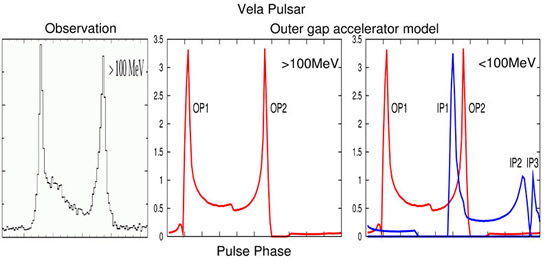研究成果藝廊 > 理論天文物理理論天文物理
(Theory)
研究成果藝廊
理論天文物理理論天文物理
(Theory)
| Non-thermal Emissions from Pulsars |
|
圖片來源: Takata, J., Chang, H.-K. and Shibata, S.

The figure compares between the light curves (>100MeV) of the observation and the theory.
|
| Emissions from pulsars are observed as a pulsed emissions. The light curves of the emissions have one, or two, or more peaks in a single period. The morphology of the light curves are good tools to study the geometry of the emissions regions in the pulsar magnetospheres. A common feature of observed light curves in gamma-ray bands (>100MeV) is double peak structure in a single period. The geometry of the outer gap can naturally explain this double peak structure. The figure compares between the light curves (>100MeV) of the observation and the theory. Also the theory predicts a light curves that have three or four peaks below 100MeV. This prediction will be check by the next-generation gamma-ray space telescope, GLAST, which will be launched in 2008. (Takata, J., Chang, H.-K. and Shibata, S., 2008, MNRAS, 386, 748) |
 asiaa.sinica.edu.tw 媒體連絡: epo
asiaa.sinica.edu.tw 媒體連絡: epo asiaa.sinica.edu.tw
asiaa.sinica.edu.tw